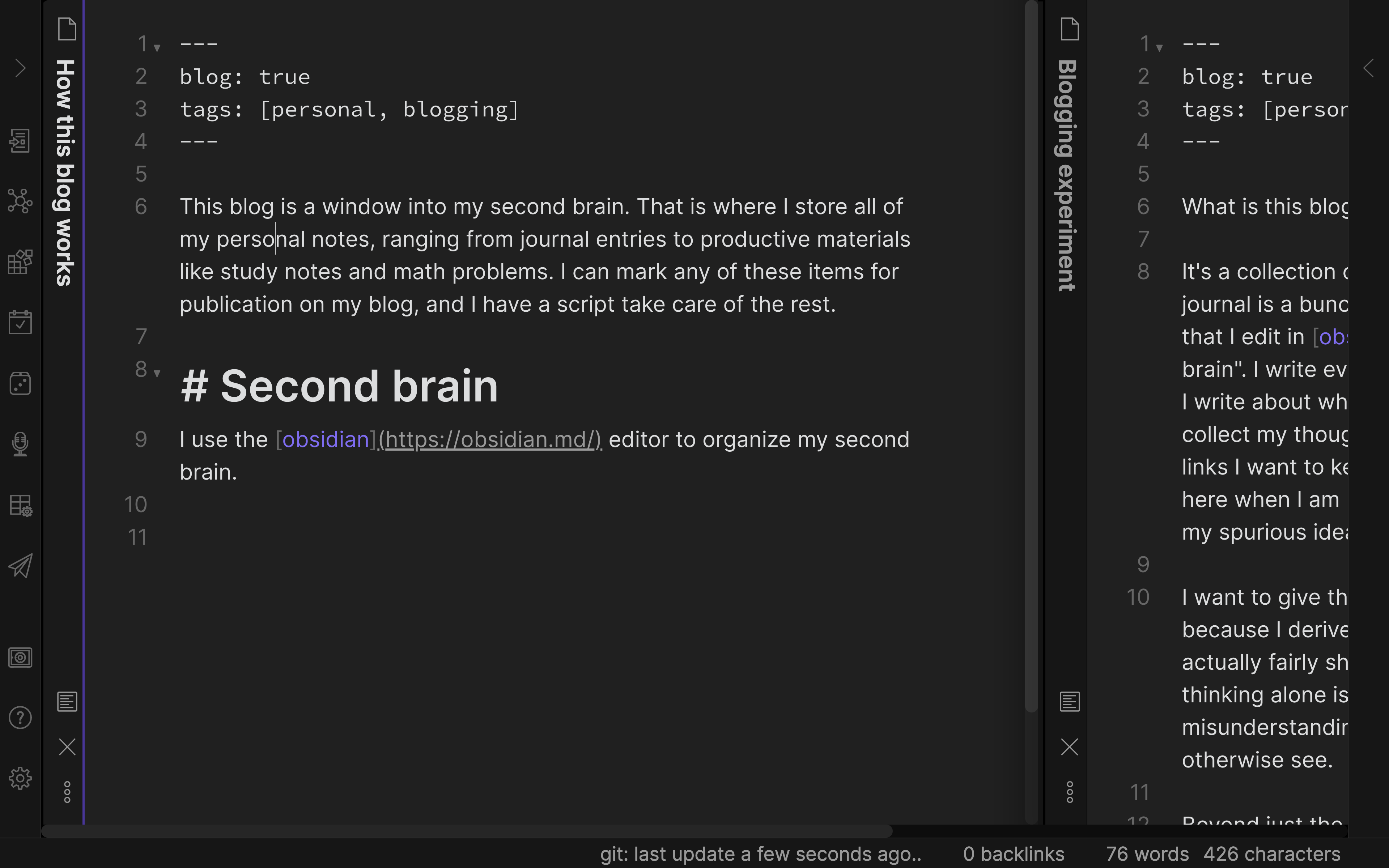[This is a note, which is the seed of an idea and something I’ve written quickly, as opposed to articles that I’ve optimized for readability and transmission of ideas.]
This blog is a window into my second brain. That is where I store all of my personal notes, ranging from journal entries to productive materials like study notes and math problems. I can mark any of these items for publication on my blog, and I have a script take care of the rest.
Second brain
I use the Obsidian editor to organize my second brain. It looks like this:

Writing some blog posts in Obsidian.
Every note is a markdown file, with support for extra features like MathJax (latex math mode), and some of the features in Roam, namely wiki-style internal links. So [[Blogging experiment]] becomes Blogging experiment. It has some convenient features like being able to paste images from my clipboard and auto-generate an image embed command:

Previous screenshot I pasted into this very markdown file.
There is also a nifty graph view of all my notes:
![Looks like a constellation! Each node is a markdown file. Each edge is due to one file linking to another with [[...]]. I’m not yet sure how helpful this is, but it’s nice to have a way to look at everything at once, in lieu of a traditional hierarchical structure.](/Pasted%20image%2020210206140906.png)
Looks like a constellation! Each node is a markdown file. Each edge is due to one file linking to another with [[...]]. I’m not yet sure how helpful this is, but it’s nice to have a way to look at everything at once, in lieu of a traditional hierarchical structure.
Publishing flow
My blog is written in Hugo (for now), which is a static site generator that takes markdown files as input. Ideally, I could just run hugo directly on my Obsidian directory, but (1) I don’t want to publish everything and (2) Obsidian defines its own extended markdown syntax, as I explained above. My workaround is to have a script copy and transform my Obsidian notes marked for publication. Here’s how I do it…
Markdown files can optionally have a frontmatter, which is a yaml header at the top of the page. For example:
---
title: Hello World
author: John Doe
---
In any note in my second brain (Obsidian), I can set blog: true and that note will be published on my blog.
Every so often, I run publish.sh from the blog repo, which in turn runs blog.py.
blog.py is where the magic happens. It’s a Python script that uses fire to give it a CLI. It will go through all the markdown files in my second brain directory and look for the ones with frontmatter containing blog: true. For those files, it will do a few transformations, like converting internal links, [[...]] and Obsidian’s image command ![[...]] to regular markdown. It also scrubs markdown comments, <!-- ... -->, and anything inside a <!-- hide -->...<!-- endhide --> pair so that I can have private sections inside published notes.
Code to transform Obsidian markdown to Hugo markdown:
def transform_body(self, body):
# Remove local-only blocks
body = re.sub(r'(<!--\s*hide\s*-->.*<!--\s*endhide\s*-->)', '', body, flags=re.DOTALL | re.MULTILINE)
# Remove everything after unclosed `<!-- hide -->`
body = re.sub(r'(<!--\s*hide\s*-->.*)', '', body, flags=re.DOTALL | re.MULTILINE)
# Remove comments
# https://stackoverflow.com/a/28208465
body = re.sub('(<!--.*?-->)', '', body, flags=re.DOTALL | re.MULTILINE)
# Transform internal links (wiki-style links).
# https://gohugo.io/content-management/cross-references/#use-ref-and-relref
body = re.sub(r'([^!])\[\[(.*?)\]\]', r'\1\{\{\< locallink "\2" \>\}\}', body, flags=re.DOTALL)
[Edit: I’ve since updated blog.py to use an iterator-based parser so that I can ignore comments and wiki-links inside code blocks, which is a problem I ran into writing this very post!]
For internal links, I call the locallink Hugo shortcode I made, i.e. {{ locallink "..." }}, which checks if the given post name exists. If so, it returns an anchor to the absolute URL for that note. If not, it returns a red anchor indicating the post does not exist, . That way, if I’ve referenced a note that is not marked for publication, the current note will be published. The red link is kind of like a missing wiki page. Perhaps if readers become curious about notes I didn’t publish, I might become motivated to publish them.
locallink Hugo shortcode:
{{ $name := (.Get 0) }}
{{ $postFile := (print "content/posts/" $name ".md") }}
{{ if (fileExists $postFile) }}
<a href\="{{ ref . $name }}"\>{{ $name }}</a\>
{{ else }}
<a href\="" class\="broken"\>{{ $name }}</a\>
{{ end }}
publish.sh will first run blog.py, and then run git commit -v which shows me the diff. If I add a commit description in the prompt, publish.sh will go ahead and push the changes, and then update the gh-pages branch. If I quit the editor without adding a commit message, publish.sh will abort.
Reader experience
Currently the reader sees a typical blog layout: a “blog roll” of recent posts with previews and tags. I don’t intend my notes to have any particular time ordering. Notes are objects in flux. I might edit anything. Since I’m using time of last edit as the post date, anything I touch will float back to the top. I might decide to change that.
